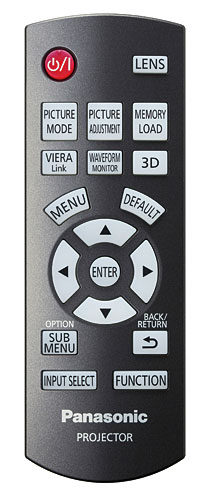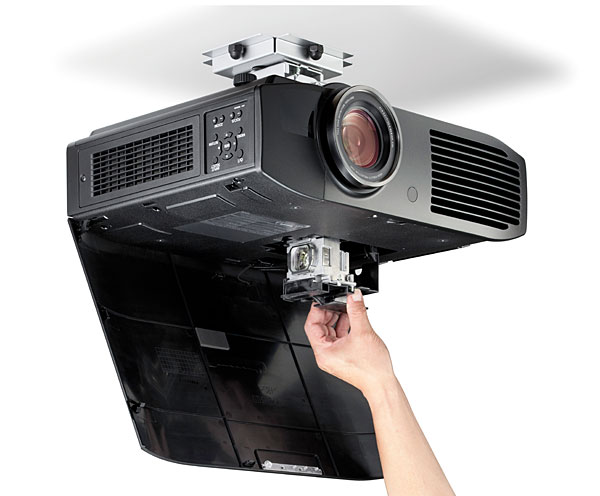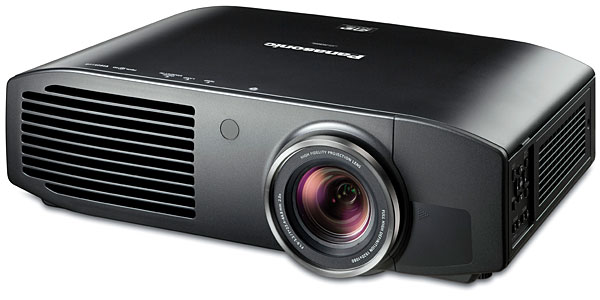Hello, I recently have purchased the panasonic pt- ae8000. What I was wondering is what settings did you end up settling with after the calibrations?
Thanks.
Panasonic PT-AE8000U 3D LCD Projector Page 2
2D Performance
The Panasonic’s video processing was good, though it stumbled with 2:2 pulldown in either HD or SD—a fairly common failure. There was also some discoloration on the highest-level luminance (luma) resolution test burst. This is common to many LCD and LCOS projectors. It also showed up in the projector’s otherwise pristine performance on a pixel phase (1:1, input to output pixel perfect) test pattern but was never visible on real program material.
 The PT-AE8000U produced watchable results out of the box (Cinema 2 picture mode, the color temperature control on –2, with user adjustment of the other basic control settings), but I still strongly recommend a good calibration. Dialing in a decent gray scale with the right tools in the Cinema 2 picture mode was relatively straightforward. But mixing and matching this with the color management system and all the custom gamma adjustments took me down more blind alleys than I care to recall.
The PT-AE8000U produced watchable results out of the box (Cinema 2 picture mode, the color temperature control on –2, with user adjustment of the other basic control settings), but I still strongly recommend a good calibration. Dialing in a decent gray scale with the right tools in the Cinema 2 picture mode was relatively straightforward. But mixing and matching this with the color management system and all the custom gamma adjustments took me down more blind alleys than I care to recall.
The projector’s out-of-box color gamut was far from correct, with significant oversaturation in green, yellow, and red. I can’t say this looked bad—manufacturers often deviate from industry gamut standards to make colors pop. But oversaturated colors don’t accurately reproduce the source. The CMS produced definite improvements, but the three controls provided per color (Color, Tint, Brightness) were highly interactive and required much trial and error to get right. I never achieved what I thought were fully satisfactory results for red, magenta, or blue, but corrections of green, yellow, and cyan helped put things on the right track.
Panasonic’s custom gamma feature received a standing ovation from my geeky alter ego, but my inner pragmatist found it too clever by half. It takes almost six pages in the (full) owner’s manual to explain, and it took me many hours to scope out. I finally decided that the factory Advanced3 setting worked as well or better for me than any of my tedious attempts to go the custom route. It looked far from perfect on the meter (particularly with the dynamic iris on—these devices juggle with gamma by design to produce a visually acceptable compromise). But none of my custom attempts measured significantly better or produced a better subjective result.
I did use the dynamic iris for all of my viewing and was never conscious of its operation. It produced no pumping or other visible artifacts. With a full black image, the corners of the screen were a little grayer than the near-black center, but not enough to be bothersome. The iris didn’t appear to drop the black level all that much, but it did punch up the highlights in dark scenes and enhanced the subjective contrast. The projector’s black level and shadow detail weren’t the best we’ve measured, but they were visually satisfying, particularly for a budget projector.

At roughly 20 foot-lamberts on a 96-inch-wide Stewart StudioTek 130 screen (gain 1.3), the Panasonic produced a bright, punchy 2D picture with brightness to spare in its Normal (high) lamp setting. The screen I used is actually 118 inches wide, so at one point in my evaluation, I zoomed up the image to fill the entire screen. The brightness dropped by just under 24 percent, but there was enough spare gain left in the projector that I could increase the contrast setting and restore much of the loss—at least in 2D.
The Panasonic’s images were compelling at either size, but I did most of my watching at the 96-inch width, judging this to be closer to the size most buyers of a projector at this price will likely use. In its 2D form, The Avengers looked punchy and surprisingly three-dimensional, with rich color, excellent resolution, good blacks, and respectable shadow detail.
Mirror Mirror may be the oddest take ever on the Snow White story, but there was no doubt about the projector’s ability to present it convincingly. This movie’s color scheme is clearly sepia toned, but within that framework, its colors were vibrant. Small details were also impressively rendered, including the pores on Julia Roberts’ face, the stubble on Nathan Lane’s cheeks, and every crease in the elaborate costumes.
John Woo’s beautifully photographed and (some might say) excessively complex and overlong, two-part Chinese historical drama Red Cliff also came across spectacularly well. While this film’s colors aren’t brilliant, they’re warm and rich. The images were sharp, though with more film grain than on Mirror Mirror. Red Cliff was shot on film in Super 35, Mirror Mirror on 24-fps digital video, and the different looks of the two processes were clearly visible on the Panasonic.
There was, however, a small issue with white uniformity. With a full-white-field test pattern, the left and bottom of the screen had a subtle magenta tint in comparison with the rest of the picture. I also have a test disc with a variety of real images, one of which shows a mostly white table setting—plates, cups, napkin, etc. There was no mistaking the color shift on that source, but it was impossible to spot on most normal images.
3D Performance
I started off my 3D adventures in the 2D calibration settings, but the image was too dim, particularly on dark scenes. I next tried switching to the Dynamic mode. While it offered a reasonably bright image, it also looked inconsistent from scene to scene and ultimately proved unsatisfactory.

I soon returned to the Cinema 2 picture mode but modified it as needed for 3D, mainly by increasing the contrast setting further than is technically optimum. I was able to achieve a reasonable white balance up to about 70 percent of peak white. As was the case in 2D, the dynamic iris looked better than it measured.
But the peak brightness in this 3D setup was less than 20 percent of the peak brightness in 2D, even with everything cranked well beyond the levels authorized in the calibrator’s catechism. The colors were a little pale but believable. Dark scenes—the night scenes in Avatar, the opening sequences in The Avengers, and more—looked dim enough to be happening in a real night environment. But 3D shadow detail was middling at best. The 3D effects, however, were good. I did see some ghosting on title lettering against a dark background and on some familiar scenes prone to it, but nothing I couldn’t live with.
Conclusions
The Panasonic is an impressive 2D projector with a load of useful adjustments. With its bright, bold picture, fine detail, good contrast and black level, and the ability to do all of this on a more than comfortably large screen, it offers impressive performance. The white uniformity issue may bother some perfectionists, but it was subtle and, on most material, invisible.
The Panasonic presented a bright, bold, and finely detailed 2D picture that can fill a more than comfortably large screen. Once calibrated, I definitely enjoyed my time watching it. But its white uniformity issue, while hard to spot on most program material, may well bother perfectionists. That, along with its acceptable but below-average contrast ratio for a projector in this price range with a dynamic iris, is the primary concern that keeps it from earning our Top Pick designation.
Then there’s the 3D brightness issue. To be fair, most relatively affordable home theater 3D projectors have serious trouble with 3D brightness, and the PT-AE8000U is no exception. A higher-gain and/or smaller screen will help, but at some sacrifice in 2D performance.
Still, if most of your 3D source material is brightly lit (that’s true of most animated features but less so of live action) and 3D is more of an occasional event in your home than a daily feast, the Panasonic’s well-defined, deeply rendered 3D images just might get the job done.
- Log in or register to post comments


As I understand it, the lack of motorized lens shift is not an issue when, e.g. shifting from 16:9 to 2.3x:1, as when programming this feature, the setup adds a step in the macro sequence that digitally shifts the image up and down on the chips. IIW, you set the zoom for each aspect ratio, then center the image for each, digitally, and this is remembered as part of the sequence when you shift between them. No need at all to mess with the physical lens shift after initial placement and physical setup.
So, actually, this is a highly desirable feature exactly because of this capability, among Constant Image Height (CIH) cognoscenti. And, it's been around for awhile. The AVS boards have exploded with enthusiasm over this CIH-without-anamorphic-lens feature--for the last four generations of Panny PJs that have had it (including the "drought" between the PT-AE4000 and the PT-AE7000). So, from CEDIA 2008 (PT-AE3000u announcement) until now...it's been one of Panny's huge selling points--or at least "product-differentiator"--until recent efforts from competitors to offer similar features and programming have resulted in more marketplace choice.
Frankly, I'm surprised it took so long...I had predicted that Panasonic's mid-tier PJ arch-rival (but, ironically, Panny's LCD chipset supplier) Epson, at least, would've jumped on this feature within a product cycle, given their competition (mutual domination) in the space. Took awhile for anybody to get all that excited about offering competition. But, as the technology and market matures before the "next big thing" [LED? Lasers? 16K HD?(!]), etc., I guess we all win when manufacturers double-down on features, even if real performance advances merely minutely. If I were to buy a PJ tomorrow, for example, Lens Memory-type features as implemented on the 8000u would be a must-have feature, period. (Perhaps with the Elite Osprey dual-screen setup, for well under two grand...a compelling "top of the midrange/tasting the high-end" duo, depending on PJ choice. Would that the feature were truly ubiquitous, however.)




































































